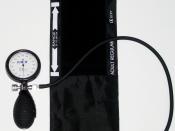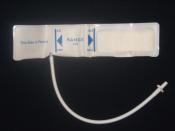Assessing Blood Pressure
When assessing a patient you must perform numerous tasks. These tasks are used to determine a diagnosis. A diagnosis is the process of identifying the disease or illness the patient is suffering from. The tasks completed during the assessment include obtaining a set of vital signs, gathering a patient history, and performing a physical exam. Some of the most important datum gathered from the assessment will be the patient's vital signs.
A set of vital signs is a set of measurements that indicates the current status of the patient. Included in a set of vital signs and one of the most important measurement you will collect is the blood pressure ("First Aid & Emergency Care"). This set of numbers is used to determine the amount of pressure the blood is exerting against the arterial (vessels throughout the body that carry oxygenated blood to tissues and organs) walls ("First Aid & Emergency Care").
A patient's blood pressure varies pending on his/her age, sex and medical history.
Many new healthcare providers do not know how to correctly obtain an accurate blood pressure. Most of the time they do not hear the pulse arterial beat clearly; sometimes they do not know how to use the instruments (sphygmomanometer - blood pressure cuff, stethoscope - a pair of ear pieces attached to a bell/diagram with tubing) properly. Taking an accurate blood pressure comes with experience. The following steps will illustrate the proper technique for obtaining an accurate blood pressure.
First, select the appropriate blood pressure cuff that suits your patient's body size. Fasten the cuff tightly to the arm of your patient above the elbow (Marieb 730). The blood pressure cuff will have an indicator printed on it that will help you position the cuff with respect to the crease of the...


